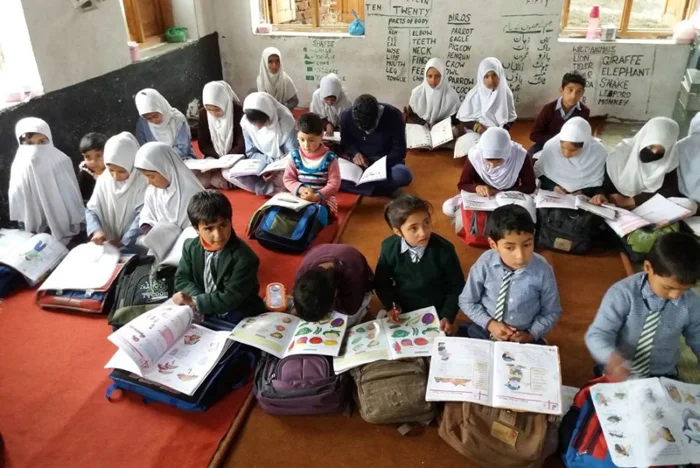
By Farooq Shah
In Jammu and Kashmir, a region marked by historical conflict that deeply affected its work environment, individuals who previously wielded influence entrenched themselves in the conflict, exercising a significant control on almost all the spheres of life. From time to time, they issued strict directives that disrupted the work culture, especially within the Education sector.
For years if not decades, a persistent issue plagued the schools in our region. The self-styled managers of the conflict would arbitrarily force the closure of schools for extended periods.
At the slightest provocation or due to their interference, schools would shut down for weeks on end, causing a substantial loss of instructional days throughout the academic year. This recurring practice persisted unchecked, resulting in a significant impact on students’ education and disrupting the entire schooling system.
The routines of all staff members, particularly teachers, were so disturbed that specific individuals with vested interests manipulated the entire system, causing the education system in the valley to almost collapse. Both education and healthcare emerged as two primary sectors severely impacted by the conflict, resulting in widespread consequences.
The conscientious members of the community persistently pursued remedies for this issue, actively seeking methods to free the education system from the influence of those wielding power. They made relentless efforts to disentangle the education system from the hold of such authoritarian figures, but their endeavors were consistently blocked.
Just before the situation could worsen and the valley’s education faced a crisis, the administration intervened and introduced a highly effective system that ultimately resolved the issue: GPS-based attendance. This system greatly increased attendance rates, almost reaching maximum capacity and indicating a remarkable enhancement.
The newly implemented attendance system imposes strict control on the teaching staff, prohibiting tardiness or early departures by requiring them to check in and out with remotely monitored timestamps using their own cellphones.
This system’s strength lies in its ability to verify a teacher’s physical presence within their designated location, substantiated by their photograph, preventing any chance of impersonation. This stringent system compels teachers to alter their behavior, disallowing any laxity in their approach even if they had previously considered it.
Despite its seemingly intrusive nature, the implementation of GPS-based attendance was an imperative step considering the dire state of the education system, particularly within the valley.
While critics might contend that teaching, being a noble profession, shouldn’t be subjected to such stringent monitoring, it’s essential to recognize the unique circumstances in this region.
Unlike certain Western societies where individual responsibility is more pervasive, the situation here necessitated a more structured approach. Just as treating a severe illness often requires therapy or even surgery, addressing the significant issues plaguing the education sector demanded a similarly drastic intervention.
The GPS-based attendance system served as a crucial tool to revive and sustain the ailing education apparatus, serving as a necessary remedy to a complex problem.
The implementation of GPS-based attendance wasn’t an experimental or trial initiative; rather, it was a deliberate government endeavor aimed at re-establishing stability in the valley. Its primary goal was to grant students, who had endured immense hardship for decades, the opportunity to attend school regularly.
This effort not only fulfilled the crucial educational objective but also provided fatigued students with additional advantages. These included engaging in sports activities and participating in various co-curricular programs, allowing them to benefit from a broader spectrum of opportunities.
The joy and contentment witnessed among students and their parents is a testament to the transformation seen in these young minds, now liberated from the confines of disrupted education.
For decades, they were denied the simple pleasure of going to school, a basic right that had been withheld due to the turmoil in the region. The psychological impact on a child forced to stay home instead of attending school is profound. It undoubtedly was a kind of imprisonment that stifled not just their academic growth but also their emotional and mental well-being.
However, with the resumption of regular schooling, there’s a tangible shift in their morale. The newfound freedom of attending classes regularly has lifted their spirits, allowing them to embrace a sense of normalcy. Their minds are now open to learning, exploring, and envisioning a brighter future.
This restoration of regular education has provided a beacon of hope, showing a clear path forward after years of uncertainty. The children are regaining their confidence, finding joy in learning, and discovering the endless possibilities that education offers. For both students and parents, seeing their children liberated from this educational confinement has become a source of immense happiness and a promising outlook for the future.
The sentiments echoed by citizens and parents regarding the recently implemented system are overwhelmingly positive. When asked for their feedback, they express genuine happiness and gratitude towards the government for its introduction.
Their collective praise underscores the appreciation and satisfaction felt within the community. This widespread approval signifies the system’s success in meeting the needs and expectations of those directly impacted by its implementation. The resounding support from citizens and parents serves as a testament to the system’s efficacy and its significant contribution towards enhancing the educational landscape.
The remarkable success achieved through the implementation of GPS-based attendance in the education sector signals a pivotal moment for considering its application in other critical domains, particularly healthcare.
Much like the education sector, healthcare also suffered severe setbacks and challenges, bringing it to a precarious state. Despite efforts to revive it, the health sector is still struggling, unable to operate at its full potential.
Expanding the scope of GPS-based monitoring to encompass the healthcare sector appears to be a logical step forward. Introducing a similar robust system could help address the existing deficiencies, streamline processes, and ensure accountability in healthcare delivery.
By incorporating technological advancements similar to those witnessed in the education system, it’s possible to bring about a transformative change in healthcare. The integration of such a system has the potential to elevate the standards of healthcare services, aiding in better management, efficient resource utilization, and ultimately, improving the overall health outcomes for the community.
Therefore, it’s imperative to expedite the inclusion of this technology in the healthcare sector to initiate a much-needed revival and ensure its ability to function effectively.
- Views expressed in the article are the author’s own and do not necessarily represent the editorial stance of Kashmir Observer
Follow this link to join our WhatsApp group: Join Now
Be Part of Quality Journalism |
Quality journalism takes a lot of time, money and hard work to produce and despite all the hardships we still do it. Our reporters and editors are working overtime in Kashmir and beyond to cover what you care about, break big stories, and expose injustices that can change lives. Today more people are reading Kashmir Observer than ever, but only a handful are paying while advertising revenues are falling fast. |
| ACT NOW |
| MONTHLY | Rs 100 | |
| YEARLY | Rs 1000 | |
| LIFETIME | Rs 10000 | |









